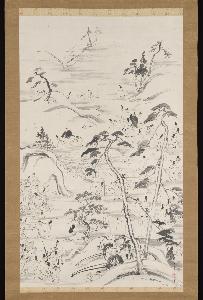Reizei Tamechika
Okada Tamechika;Reizei Tamechika
Place: Kyoto
Born: 1823
Death: 1864
Biography:
Reizei Tamechika, also known as Okada Tamechika, was a Japanese artist from the later Edo Period who played a significant role in reviving the classical style known as Yamato-e. Born on October 20, 1823, in Kyoto, Japan, Tamechika was the third son of the painter Kanō Eitai. He became dissatisfied with the prevailing Kanō school style and took up the older Yamato-e style instead.
Artistic Career
Tamechika spent many years collecting examples of Yamato-e art from the Heian and Kamakura periods, which inspired his own unique style. He was especially interested in the works of Fujiwara no Nobuzane, a Kamakura artist known for his classical techniques. Under the name "Reizei" or "Fujiwara", Tamechika produced numerous works on traditional themes, using ancient techniques. His later works, such as the Fusuma-e (sliding door pictures) at the Daiju-ji temple in Okazaki, use classical themes but are presented with a more modern approach.
Politics and Tragic End
Tamechika's revival of Yamato-e art got him involved with Sonnō jōi, the movement to restore the Emperor. He supported the restoration, but his professional contacts with the Sakai clan, who were "Fudai daimyo" (vassals and retainers) of the Tokugawa Shogunate, created suspicion among some of the more radical samurai supporters of the Emperor. As a result, he was forced to hide in Wakayama Prefecture and adopt the priestly name "Shinrenbō Kōa". Unfortunately, he was discovered and murdered by hired assassins from the Choshu Clan on June 8, 1864.
Legacy
Tamechika's legacy can be seen in his beautiful works of art, which are now housed in various museums and collections. His paintings, such as Emperor Enyū’s Outing to Funaokayama on the First Day of the Rat in the New Year, showcase his mastery of traditional Japanese techniques. To learn more about Reizei Tamechika's life and work, visit Reizei Tamechika's page on Wikioo.org or check out his biography on Wikipedia.
- Some of Tamechika's notable works include: Yamato-e style paintings inspired by the Heian and Kamakura periods Fusuma-e (sliding door pictures) at the Daiju-ji temple in Okazaki Portraits of Buddhist themes due to his friendship with a priest named Gankai
- Visit The Yamato e Art Movement page on Wikioo.org to learn more about the art movement that Tamechika was a part of.
- Check out other notable Japanese artists, such as Tachibana Morikuni and Ike Taiga, on Wikioo.org.
contribution to the world of Japanese art is undeniable, and his legacy continues to inspire artists and art lovers alike. His beautiful paintings and tragic story serve as a reminder of the importance of preserving traditional techniques and cultural heritage.


